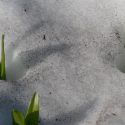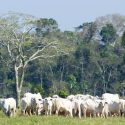Students create new environmental strategy for Lake Ripley
With the help of University of Wisconsin–Madison students, communities around Lake Ripley in southeastern Wisconsin are among the first in the state to use an innovative social strategy known as community-based social marketing, or CBSM, to deal with an environmental problem.
Students in Rick Chenoweth‘s Human Behavior and Environmental Problems course this semester teamed up with the Lake Ripley Management District to create a plan centered on CBSM, an approach to promoting social behaviors that draws heavily on social psychology. CBSM has shown promise in medical campaigns, but its use in advancing environmental goals has outreach professionals around the state taking notice.
"CBSM got its legs in the medical community," says Chenoweth, a professor and environmental psychologist in the UW–Madison department of urban and regional planning. "Health professionals realized that many people were knowledgeable about the harmful consequences of their lifestyle yet continued doing the harmful behaviors." Community-based social marketing is about finding the strategies that result in real behavior change, he says.
In the Lake Ripley watershed, water-quality concerns stem largely from the runoff of phosphorous, a nutrient commonly used in fertilizers. The students set out to find a set of behaviors that would decrease the amount of phosphorous that reaches the lake. They settled on the planting of rain gardens and use of phosphorous-free fertilizer as tangible target behaviors that they could promote and then used CBSM techniques to discover how to help people adopt these behaviors.
The students adopted CBSM because research shows that traditional education campaigns aren’t always effective. Informational brochures may change attitudes and beliefs, but urging people to "do the right thing" doesn’t usually change their behavior. CBSM focuses on what may be preventing people from changing those behaviors — why, for instance, they keep smoking even if they know it’s bad for them. It uses focus groups and other market research to identify the barriers to changing behavior and strategies to overcome them.
"It’s important to find out what the people are perceiving is stopping them [from adopting a behavior], not what we think is stopping them," says Brendon Panke, a master’s student in conservation biology and sustainable development. "Then [the CBSM] tools that you use are specifically tied to one of those benefits or barriers that you found."
If a perceived barrier to planting a rain garden is the aesthetic factor, Panke says, a CBSM approach would attempt to attack the perception by showing how rain gardens can be planted in many ways, or by planting rain gardens spanning two properties to demonstrate their social acceptance.
"Many natural resource managers have misconceptions about how to implement social marketing programs, so they don’t ever get put into place," says Emily Sievers, a master’s student in water resource management. "It’s really important that this class is helping disseminate new knowledge and information about this particular strategy because I think it will be much more useful than what’s already out there."
For the Lake Ripley district, the class created two plans, one for each target behavior, that outline the nature of the problem and suggest strategies to change residents’ actions. But they also spell out the steps and logic behind CBSM, which has drawn the interest of many other state and local agencies. Even before the reports were finished, nearly 40 people — including staff at the Wisconsin Department of Natural Resources, UW extension agents and watershed managers — signed up to receive copies.
"We’re hoping that this plan will help the Lake Ripley Management District achieve its goals," says Paul Dearlove, lake manager of the district. "But the way the students have been documenting the process — not just the theory, but the steps — we think that is going to be a useful model for other lakes in the state. Now they have a model to do it themselves."
Dearlove plans to continue working with Chenoweth and one of his students, Paul Heiberger, during the summer to start implementing the recommendations of the CBSM plan for rain gardens.
"The students showed a significant level of enthusiasm and dedication to the project from the beginning that was very inspiring," says Dearlove. "I felt sort of like a client, but also like I was a part of the process."
For more information on this project or to receive a copy of the final report, contact Chenoweth at rechenow@wisc.edu or Dearlove at ripley@charterinternet.com.
Subscribe to Wisconsin Ideas
Want more stories of the Wisconsin Idea in action? Sign-up for our monthly e-newsletter highlighting how Badgers are taking their education and research beyond the boundaries of the classroom to improve lives.
Tags: biosciences, environment, learning, research, The Wisconsin Idea



